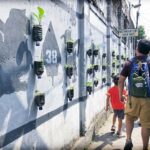20 Best Things To Do In Yogyakarta With Kids: Yogyakarta Itinerary

Contrary to what many travelers think, the best place to experience the culture of Indonesia is not Bali. In my opinion, it's the city of Yogyakarta on the island of Java. A Yogyakarta itinerary is a must for any family’s Indonesia bucket list! With so many things to do in Yogyakarta with kids, you’ll be able to get a glimpse into what Indonesia is really like.
We visited Yogyakarta as a family in 2019, but I’ve personally been visiting this city since I was a kid. The bustling city of Yogyakarta encapsulates everything that Indonesian culture is all about. It’s modern, yet traditional; busy, yet relaxed.
Yogyakarta has the same Hindu-derived arts and culture that tourists flock to Bali for. But it also has a strong spiritual heart, by way of Islam, which the majority of the country practices. And when it comes to Indonesian tourist attractions, Yogyakarta has one of the best: the iconic Borobudur Temple.

Travelers can visit Bali all they want. But if you’re looking to understand Indonesian culture, then you need to include a visit to Yogyakarta in your Indonesian itinerary, and experience the best things to do in Yogyakarta with kids. Take a look at my suggestions for the best Yogyakarta itinerary for your family.
This article was originally published on September 1, 2019.
This post may contain affiliate links. That means I may receive a small commission if you click on the link and purchase something. But don't worry, this will not result in any extra costs to you.
Yogyakarta itinerary highlights for visiting Yogyakarta with kids
Don’t have time to read the whole post? Here are my top 5 recommendations for things to do in Yogyakarta with kids for your Yogyakarta itinerary.
- Tour Borobudur and Prambanan temples
- Learn about Java’s cultural heritage
- Take a batik master class
- Watch a Ramayana dance performance
- Hang out at Alun-Alun Kidul
Where to stay in Yogyakarta
If you’re planning a visit to Yogyakarta, there are plenty of family-friendly neighborhoods to stay in while you're exploring the things to do in Yogyakarta. While you can certainly stay at places like the Hyatt Regency Yogyakarta, our family prefers to stay at more locally owned places while we’re in Yogyakarta.

When we visited in 2019, we stayed in the Danunegaran neighborhood in southern Yogyakarta, near Jalan Tirtodipuran and Jalan Prawirotaman. These two streets are popular among tourists, and are lined with restaurants and tour companies. They’re pretty close to many of the things to do in Yogyakarta, which is why this area is so popular among travelers.
If you’re looking for hotels to stay in the Danunegaran area, here are three highly rated hotels to consider. Keep in mind that most hotels in Yogyakarta will usually only have 1-2 beds in a room. So families will need to book more than one room.
Duta Garden Hotel
Duta Garden Hotel is a 3-star hotel set in a garden setting in the Danunegaran neighborhood. It’s located several blocks north of Jalan Prawirotaman, on a relatively quiet street. We stumbled across as we were walking around the neighborhood, and loved how peaceful the area felt.

Rooms at Duta Garden Hotel come with air conditioning, TV, and WiFi. There’s also daily housekeeping available. And the rooms either overlook, or have access to the garden and outdoor pool. The hotel offers laundry services, luggage storage, and airport shuttle for a fee. Babysitting is also available for families with young kids.
Greenhost Boutique Hotel
A popular 3-star hotel in the Danunegaran neighborhood is Greenhost Boutique Hotel. This hotel is located one block south of Jalan Prawirotaman. It boasts a bar, restaurant, outdoor pool, and garden. The hotel also offers bike rentals and airport shuttle services for guests.

The rooms at Greenhost Boutique Hotel only have either 1 king-size bed or 2 twin-size beds, so families will need to book more than one room. However, rooms are reasonably priced, and are quite spacious, so you’ll definitely get much value for your money. All rooms come with air conditioning, WiFi, TV, and free tea and coffee.
Adhisthana Hotel
Another 3-star hotel in the neighborhood to consider is the Adhisthana Hotel. This hotel has an outdoor pool and a restaurant that offers daily breakfasts for a fee. The architecture of the hotel is more traditional Javanese style, with accents of Dutch colonial, so you feel like you’re transported back in time to old Java.

Rooms at Adhisthana Hotel come with free WiFi and TV. Other services offered at Adhisthana Hotel include airport and train station shuttles, massages, laundry, and luggage storage. Hotel staff can also provide assistance with arranging tours around the city.
Ideas for things to do in Yogyakarta with kids
We spent a month in Yogyakarta in 2019, and to be honest, we wish we could have spent more. There were just so many things to do in Yogyakarta. And we didn’t get a chance to do them all!

Of the things that we did get to do (and thankfully, there were plenty), we were quite surprised to find that many of them were extremely kid friendly. Indonesians love children, so most places you visit in Indonesia will be welcoming of kids, no matter what age.
Here are 20 of our favorite things to do in Yogyakarta with kids. These activities will surely help you gain some insight into Indonesian culture.
1. Climb the Borobudur Temple
The Borobudur Temple is a massive Buddhist temple structure that is located about two hours outside of Yogyakarta. It’s one of the most well-known Indonesian tourist attractions (and in Southeast Asia), primarily because of its sunrise views, but also because it’s the world’s largest Buddhist temple. It’s also a UNESCO World Heritage site.

In a predominantly Muslim country, it may seem odd that people here would hold such a reverence to this temple structure. But the Borobudur temple is a real source of pride for Indonesians, and one that even Indonesians will come in flocks to visit.
In a way, the temple is a reminder of Indonesia’s glorious past, prior to the Dutch occupation, when Hindu-Buddhist kingdoms ruled the islands. Indonesian culture is full of mythology, and the Borobudur temple is just a part of the country’s mythological past.
Visiting Borobudur temple
Buses are available to take visitors to Borobudur temple, but for families, the best option is to hire a private car. Families can book a car and driver through the travel company Via Via. A 5-hour car and driver hire will cost roughly Rp. 1,000,000 IDR (roughly $65 USD) for up to 5 people.

Alternatively, you can book a private driver ahead of time online.
Entrance to the temple will be $25 (USD) for kids and adults over 10 years old, and $15 (USD) for kids between the ages of 3 and 10.
If you want a deeper experience of the Borobudur temple, you can join a guided tour. A tour will be able to provide you with more history of the temple, as well as take you to other temples.
Visiting Borobudur at sunrise
For the ultimate Borobudur experience, come during sunrise. Mornings at Borobudur have the least amount of tourists and are also the coolest times of day. It’s also the most picturesque time to visit the temple!
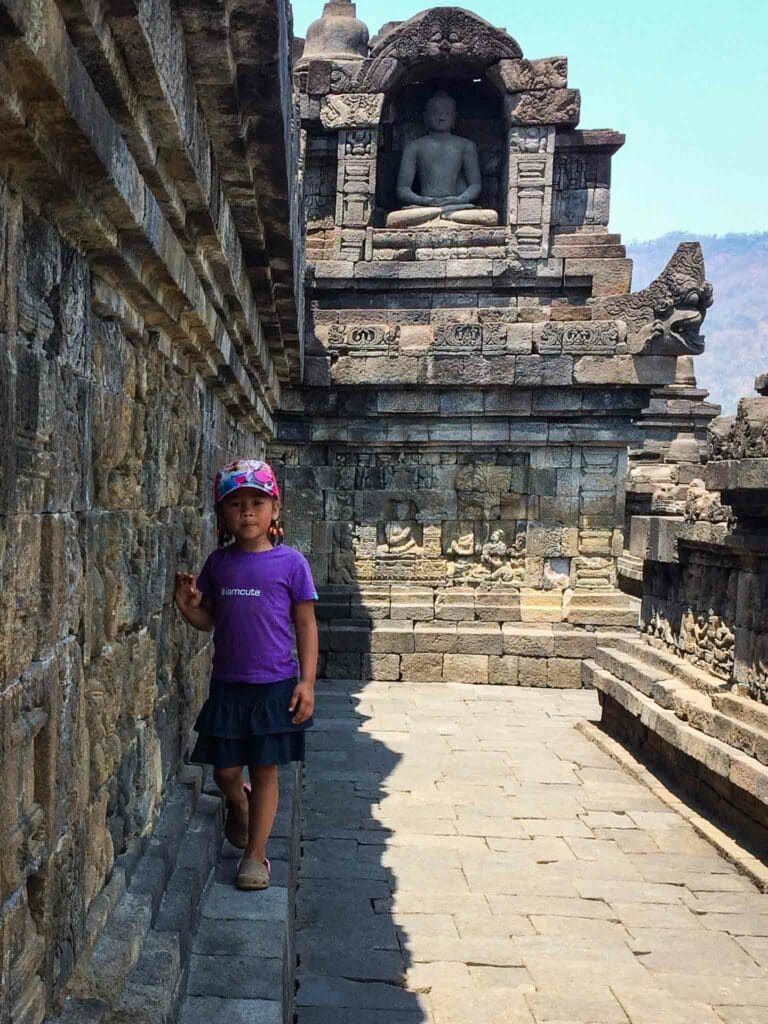
You can leave Yogyakarta in the wee hours of the morning to catch a sunrise tour. Alternatively, you can book an overnight stay at a nearby hotel. These hotels are all within a 10 minute drive from the temple.
2. Marvel at the ruins of Prambanan
Another important part of Indonesian culture and history is the Prambanan Temple complex. It’s the largest Hindu temple in Java and a UNESCO World Heritage site. Unlike Borobudur, these temples are Hindu rather than Buddhist, but they still hold a similarly high level of reverence among Indonesians. We visited Prambanan in 2015, and we were so impressed by its beauty!

Built in the mid-9th century, these temples harken back to the glories of Java’s empirical past. Today, visitors can walk around the temple grounds, and look inside many of the temples. And in the evenings, Prambanan becomes the backdrop to dance performances of the Hindu epic, The Ramayana.
Tickets to Prambanan are $25 (USD) for kids and adults over the age of 10, and $15 for kids between 3 and 10. You can bundle a ticket with Borobudur for $45 (USD) for kids and adults over 10 years old, and $27 (USD) for kids between 3 and 10.
For the Ramayana Ballet, tickets range from Rp. 150,000-450,000 per person (roughly $10-$29), and will need to be reserved separately and ahead of time.
3. Experience royal history at the Keraton
If you can’t tell, Yogyakarta is proud of its historical and royal past. You can see it quite clearly if you visit the Keraton Yogyakarta (the royal palace), located in the historic city center. A visit to the Keraton is a must for things to do in Yogyakarta, because you observe so much of Javanese culture there.

The sultan, Hamengkubuwono X, still lives at the palace, and also serves as the governor of the Yogyakarta region. You can tour some of the rooms that are open to the public. And each day, from 10am to 12pm, there are cultural demonstrations that visitors can enjoy, including music performances, wayang golek (wood puppets) performances, traditional poetry recitings, wayang kulit (shadow puppet) performances, and traditional dancing.
Entrance to the Keraton is Rp. 25,000 per person (roughly $1.65). And there is a separate fee for use of a camera.
You can visit the Keraton on your own. Or if you want to make the most of your Yogyakarta itinerary, book a heritage tour that includes the Keraton along with other historical places (Taman Sari water castle and Sonobudoyo Museum, described below).
Budgeting for a trip to Indonesia? Read my Indonesia travel budget post for ideas.
4. Learn Indonesian history at Taman Sari
Besides the Keraton, another royal building worth visiting is Taman Sari. Built in the 18th century, Taman Sari was built as a pleasure palace for the sultan of Yogyakarta at the time. The buildings, also known as the Water Castle, have two pools that the sultan and his many wives and concubines would bathe in.

A visit to Taman Sari provides a glimpse into the stratified and inegalitarian society of Java’s past, with the sultan occupying a god-like position at the top. Fortunately, Indonesia has progressed much since then.
Entrance to Taman Sari is Rp. 30,000 (roughly $2) per person. If planning a visit, hire a guide for an additional Rp. 50,000 per person (roughly $3.25). A tour guide is helpful in providing meaning and explanation to the architecture, as well as insight to the palace’s history.
To maximize your Yogyakarta itinerary, book a heritage tour that includes Taman Sari, along with the Keraton (described above) and the Sonobudoyo Museum (described below).
5. Learn about Indonesian culture and history at Sonobudoyo Museum
Speaking of learning about Indonesian culture, located near the Keraton is the Sonobudoyo Museum. It’s a great place to see artifacts from Indonesia’s past, including batiks, gamelan instruments, prehistoric tools, and even royal weapons!

The museum also has two complete Javanese gamelan sets (traditional Indonesian percussion instruments) on display. As someone who has spent over a decade learning and playing traditional Javanese gamelan music, I was over the moon. They even let me play a few notes on one of the instruments!
The museum is open everyday of the week from 8:00 am to 3:30 pm. On Fridays, the museum closes at 2:00 pm. Admission to the museum is Rp. 20,000 (roughly $1.30) per person.
As with the Keraton and Taman Sari mentioned above, you can maximize your Yogyakarta itinerary by booking a heritage tour that includes all three of these attractions.
6. Watch a wayang performance
Every night, except for Sunday nights, the Sonobudoyo Museum puts on a wayang kulit performance from 8:00 pm to 10:00 pm. Wayang kulit are shadow puppets made from leather (kulit means skin in Indonesian). The stories performed at the Sonobudoyo Museum are episodes from either the Hindu epic, Ramayana, or sometimes from the Mahabarata.

Wayang kulit came to Indonesia by way of India, around the time that Hinduism came to the islands. Although Hinduism (and Buddhism) eventually became usurped by Islam in Indonesia, the wayang kulit traditions and stories remained.
In the past, wayang kulit performances would often last all night, with the gamelan orchestra accompanying the puppeteer, known as the dalang. During the Nationalism movement in Indonesia in the 1920’s, when the country was trying to gain its independence, wayang kulit performances were often used as a way to spread nationalist messages!
Tickets to the wayang kulit performances at Sonobudoyo Museum are Rp. 50,000 (roughly $3.25). The setup is such that you can sit on either side of the screen. So you can watch the shadows on the screen. Or you can watch the dalang and the gamelan at work, which is equally as exciting.
7. Experience Indonesian culture at Alun-Alun Kidul
One of our favorite things to do in Yogyakarta is to ride a bicycle-car at Alun-Alun Kidul. This is an activity that you will most likely not find in your typical list of Indonesian tourist attractions. But for families putting together a Yogyakarta itinerary, it’s truly something you can’t miss!

The bicycle-cars are old VW beetles and vans that have been gutted and fitted with benches and bicycles inside. The outside is decorated with different colored lights, and there are usually speakers blaring pop music as well. A ride around Alun-Alun Kidul will cost between Rp. 60,000-100,000 (roughly $4-6). These bicycle-cars are only available at night, starting after sunset.
Alun-Alun Kidul is a popular spot for locals to hang out at night, including families. Food stalls, known as warungs, line the streets, and vendors will sell toys for kids throughout the grassy area. Plus, there are games you can play there. Alun-Alun Kidul is a great place to catch a glimpse of how local families hang out together.
You can make your visit to Alun-Alun Kidul even more fun with a night time street food tour.
8. Stroll through a kampung
During our time in Yogyakarta, we stayed in an Airbnb right on the edge of Kampung Danunegaran. In Indonesian, kampung means village, and in Yogyakarta, this can be loosely translated as neighborhood.
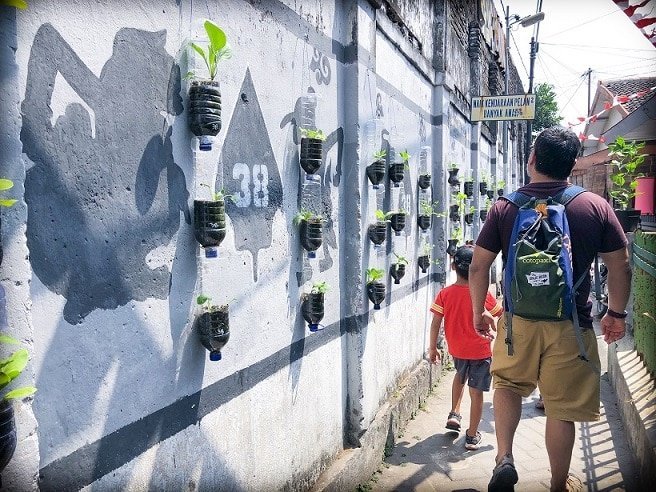
In between the main streets of Yogyakarta are little alleyways, called gangs, that wind through the kampungs. The alleys are hardly wider than the width of two motorbikes. But we loved walking along the gangs rather than along the main roads.
It was like catching a glimpse of contemporary Indonesian culture. Passing by homes with families, and children biking along the gang, we felt like we were part of a neighborhood, rather than just tourists.
You can enjoy a tour of Yogyakarta’s neighborhoods and kampungs with a morning bike tour. It’s a fun way to stay active during travel.
9. Hang out on Jalan Malioboro
You can’t have a Yogyakarta itinerary without a visit to Jalan Malioboro (known in English as Malioboro Street or Malioboro Road). It’s a popular street for travelers to hang out primarily because it’s near many of the things to do in Yogyakarta. It’s very close to Yogyakarta’s central train station.

The street is lined with shops selling batik clothes and souvenirs. Many of the things for sale are priced higher than usual, but if you’re hard pressed for time, this is a great option for souvenir shopping.
Jalan Malioboro will occasionally have street performances showcasing traditional Indonesian culture from Java or the other islands. During one of our visits to Jalan Malioboro, we saw a small street parade comprising of drummers and percussionists from the island of Lombok, near Bali.
Get a feel for Jalan Malioboro with a night walking tour led by a local travel guide. You’ll get to visit a market, sample street food, and ride one of Yogyakarta’s famous becaks (pedicabs).
10. Explore things to do in Yogyakarta at Pasar Beringharjo
If you’re looking for more affordable souvenirs and local goods, head to Pasar Beringharjo, also located on Jalan Malioboro. This public market sells clothes, batiks, textiles, bags, and traditional clothes. I bought a traditional Javanese dance costume here!

Local markets are always a great way to see how locals go about their lives, and Pasar Beringharjo is no exception. The market has a large selection of batik, Indonesia’s traditional wax print cloths. This is where you should go if you want to buy batik.
11. Take a becak around town
For the more adventurous travelers, a unique way to get around Yogyakarta is by riding a becak. These are the bicycle rickshaws or pedicabs that you can find all around the city.

A ride on a becak will depend on the distance. Expect to pay between Rp. 20,000-50,000 ($3-4 USD). We love piling all four of us into a becak and riding through the streets of Yogyakarta at night.
12. Sample Indonesian food things to do in Yogyakarta
Another great way to experience Indonesian culture is through food. Yogyakarta has plenty of restaurants serving cuisine from all over the country. But we also enjoy frequenting warungs, food stalls and small family-run restaurants.
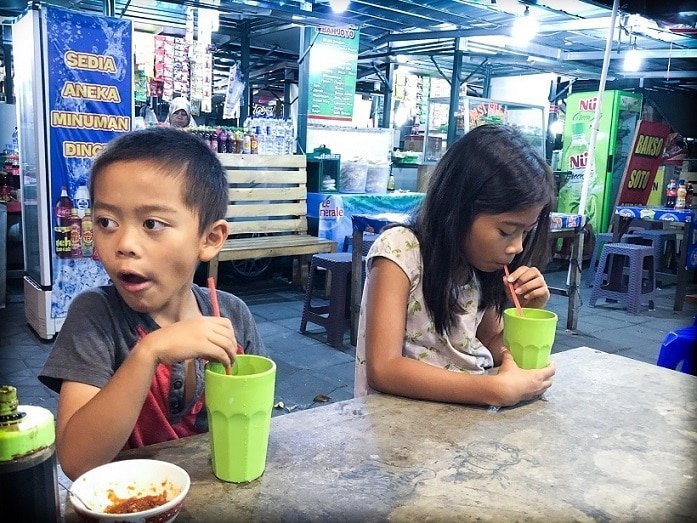
In Indonesia, a popular dish is satay, which is grilled meat on a stick. Ikan bakar (roasted fish) is also popular. Mie bakso (noodles with meatballs) and nasi goreng (fried rice) are also popular dishes. For a meatless option, try gudeg, which is a curry dish made from jackfruit.
If you happen to travel to Yogyakarta during the month of Ramadan, some of the warungs may be closed during sun down, as most locals will be fasting. But come sunset, the food stalls will be brimming with activity once again!
Another way to experience Indonesian food is by doing a cooking class! You’ll get to make popular street food snacks like martabak, tempeh, and kue putu.
Talk to your kids about travel privilege. Try these tips for talking about privilege with kids.
13. Supplement things to do in Yogyakarta with a batik course
Another one of our favorite things to do in Yogyakarta is to take a batik course. Batik is such an integral part of Indonesian culture. And although the art form didn’t originate from Indonesia, the country has refined the process so much that Indonesian batik has its own unique and distinctive look.

The process of making batik involves drawing complex wax designs and patterns on fabric, dyeing the fabric, and then boiling the fabric to release the wax. Traditional Javanese batik are double-dyed, with an additional step of adding wax to some of the dyed parts, so that the designs are two-toned.
Where to take batik lessons
We took a batik course from Batik Seno, located near Jalan Tirtodipuran. A three-hour lesson at Batik Seno costs Rp. 300,000 (roughly $20 USD) per person. The ladies Batik Seno have been making batik for thirty years!
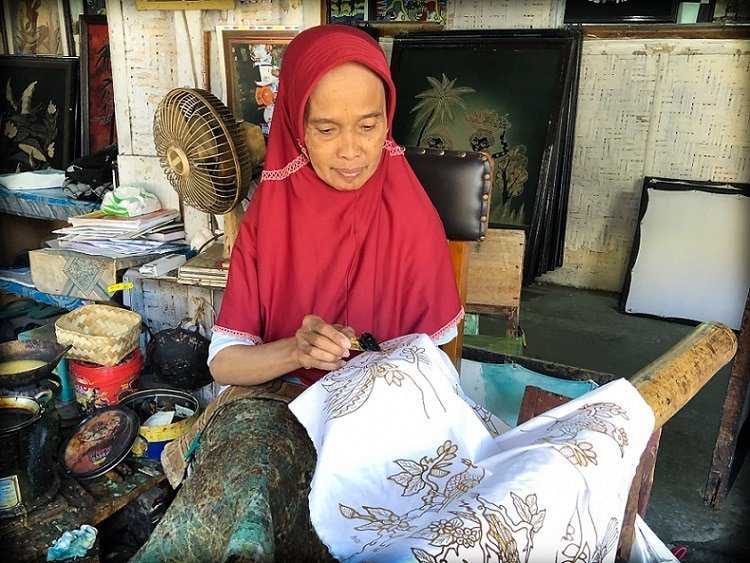
Batik Seno doesn’t have a website, so you can’t buy tickets online. So if you feel more comfortable booking things online, you can book a batik master class ahead of time through Viator.
14. Spend an afternoon at the mall
The malls in Indonesia are more than just a place for buying things, they’re also a place for socializing and hanging out. Indonesian malls can have restaurants, movie theaters, play areas, hotels, and even waterparks!

There are several malls in Yogyakarta, scattered throughout the city. They’re great places to hang out if you’re looking for a low key, yet cool (thank goodness for air-conditioning!), way to spend an afternoon.
Malioboro Mall on Jalan Malioboro is conveniently located in central Yogyakarta. But you can also head north to the more upscale Hartono Mall.
15. Ride an andong
One of the fun things to do in Yogyakarta with kids that we enjoy is riding one of the horse-drawn carts, called andong. You can find andongs along Jalan Malioboro. A ride will cost around Rp. 50,000-80,000 ($4-6 USD), depending on the distance.
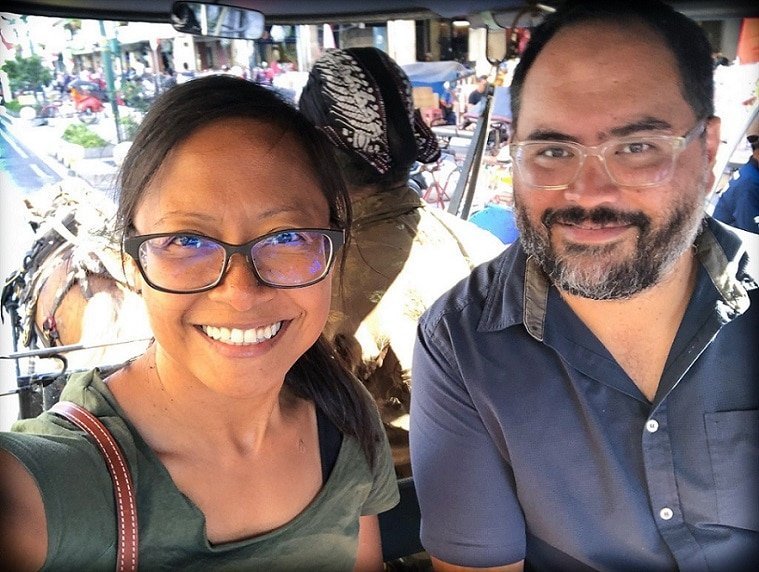
The andong drivers are dressed in traditional Javanese attire. So, it’s a fun way to imagine what life might have been like for Javanese during the colonial era, before the advent of cars.
16. Try your hand at fishing
Although Yogyakarta doesn’t have any lakes or beaches nearby, fishing is a fun activity that local families like to do. There are several fishing ponds around the city where you can catch your own fish and even have them grilled or fried for you.

Our favorite place to fish in Yogyakarta is Ledok Gebang, a fishing pond and restaurant located in northern Yogyakarta. The place has a big pond with covered bamboo platforms all around the perimeter where you can fish for the afternoon.
When we visited in 2019, fishing pole rental and bait (live and pellet) were only Rp. 3,000 ($.21 USD) each. The cost for the place to cook the fish was Rp. 95,000 (about $7 USD), and you could also order side dishes and drinks. (Note, prices have likely doubled since then.)
We spent an afternoon at Ledok Gebang and caught two fish. Along with gear rental, food, and drinks, the whole afternoon only cost us Rp. 168,000 (roughly $12)! A lot of families in Yogyakarta like to do this on the weekend, as it’s a good way to socialize in a relaxed environment.
17. Expand your mind at Taman Pintar
We love visiting science museums. So we were pleasantly surprised when we visited Taman Pintar. It was a fun museum for the kids to experience. Besides science exhibits, there are also exhibits for kids to learn about Indonesian culture and history.

Located close to the Keraton and Sonobudoyo Museum, Taman Pintar is a large complex of several buildings dedicated to kids. The exhibits are interactive and kid-friendly. And even though the condition of some of the exhibits seemed a bit old, the kids didn’t seem to mind.
Admission to Taman Pintar is only Rp. 24,000 (roughly $1.60 USD) for adults, and Rp. 14,000 (roughly $1.00) for kids. Tickets for the planetarium or learning activities are additional to the standard entrance fee.
18. Splash and play at Waterboom Jogja
We celebrated our son’s birthday while we were in Yogyakarta in 2019. And as a special treat, we spent a day at Waterboom Jogja (at the time it was called JogjaBay Pirates Adventure Waterpark). It’s a waterpark in northern Yogyakarta.

Waterboom Jogja has waterslides, both for young kids and teens and grown-ups. There is a lazy river that circumnavigates the whole park. And there is also a large wave pool, which our family really enjoyed.
Admission to Waterboom Jogja is Rp. 90,000-100,000 (roughly $7 USD) per person, depending on the day of the week. Locker rental is an additional cost. There is also food available to purchase at the waterpark.
Since Indonesia is a Muslim country, for women planning to swim, it’s wise to wear a shirt and pants over your bathing suit for modesty reasons. Full body cover-ups are available for sale at the gift shop.
Read my other Indonesia posts for more travel ideas.
19. Take an Indonesian language course
If you’re planning on spending a good chunk of time in Yogyakarta, then the best way to experience and learn about Indonesian culture is to take a language class. During our time in Yogyakarta, we took Indonesian language classes at Wisma Bahasa, a language school based in Yogyakarta.

Having access to an Indonesian teacher is so valuable, as they can provide you with so much insight into the culture. And learning more than just the standard Indonesian phrases for travelers can get you a long way to making connections with Indonesians.
Wisma Bahasa is open five days a week, but you’ll need to contact them to set up lessons. Enrollment fee is Rp. 300,000 (roughly $21 USD) per person. Private lessons for one person costs Rp. 350,000 per lesson. But the per person cost will decrease if you have two or more people in your class.
20. More ideas for a Yogyakarta itinerary
Even though we spent a month in Yogyakarta, there were still many things to do in Yogyakarta that we didn’t get a chance to experience. I’ve listed a few of the activities here. They are definitely on our list for the next time we come to Yogyakarta.

If you have more time to spend in Yogyakarta with kids, check out these additional things you can append to your Yogyakarta itinerary.
- Hike at the picturesque Seribu Batu Songgo Langit
- Visit Mount Merapi, an active volcano (see it on this tour)
- Take day trips to Jomblang Caves and Timang Beach (not recommended for really young kids)
- Spend an afternoon at Gembira Loka Zoo
- Take an excursion to Kalibiru National Park
Going beyond the touristy things to do in Yogyakarta
As visitors to Indonesia, it’s easy to just hit up the Indonesian tourist attractions and call it a day. Even in Yogyakarta, most visitors will only spend a few days in the city to visit the tourist sites and then leave for other parts of Indonesia, like Bali.

But if you really want to get a better understanding of Indonesian culture, you need to go beyond the tourist activities. This will help your kids develop a deeper appreciation for travel. Spend a little longer exploring the things to do in Yogyakarta, and try things that you won’t readily find in a guide book or on Instagram.
Getting to know Indonesian culture
Indonesian culture is complex and diverse. This archipelago of over 17,000 islands has around 300 different ethnic groups.
The largest ethnic group are the Javanese, located on the island of Java, who make up 40% of the population. But there are also the Sundanese (from West Java), the Batak (from North Sumatra), the Minangkabau (from West Sumatra), and the Buginese (from Sulawesi and Kalimantan). The Balinese make up less than 2 percent of the population.

While Java is not the largest island in Indonesia, it is certainly the most populous. Many of the Indonesian tourist attractions are located on this island. And Indonesians from other islands come to Java to study and work. As a result, the island is a microcosm of the many cultures and ethnic groups that pass through its shores.
In south-central Java, Yogyakarta holds a unique spot in Indonesian culture and politics. It’s the only region that is still governed by a sultan. And its rich cultural history and thriving traditional arts makes it a popular place for academics and art lovers to come and study. The book, Brief History of Indonesia, covers some of Yogyakarta's relevance in Indonesian history.
Learn more the island of Java by reading my Java posts.
Getting to Yogyakarta
From Jakarta (Indonesia’s capital city) or Denpasar (which is the main airport in Bali), flights to Yogyakarta run everyday. Air Asia has several non-stop flights that are about an hour in duration. Other airlines also have flights flying to Yogyakarta from Jakarta or Denpasar. But besides Air Asia, the only other airline I have flown is Garuda, so I can’t vouch for the service or quality of those other airlines.
You can find flights for Yogyakarta from destinations around the world via Skyscanner or Kayak.

Another option, if you’re coming from Jakarta, is to take a train to Yogyakarta. From Gambir station, a train will cost roughly $28-35 (Executive Class). The trains have air-conditioning, and serve food on board, although the journey will be around 7 hours.
We have not yet tried driving from Jakarta to Yogyakarta, though it’s certainly possible. If you’re going with a tour company that is taking you to see Indonesian tourist attractions, they can help you arrange the best way to get to Yogyakarta.
Getting around Yogyakarta
In terms of getting around Yogyakarta, families have several options. We prefer using GOJEK, which is a ride sharing app, much like Uber or Lyft. We also use a similar app called Grab. There are taxis that you can hail at the train station or at the airport. And there are also TransYogyakarta buses, although we have not taken them yet.
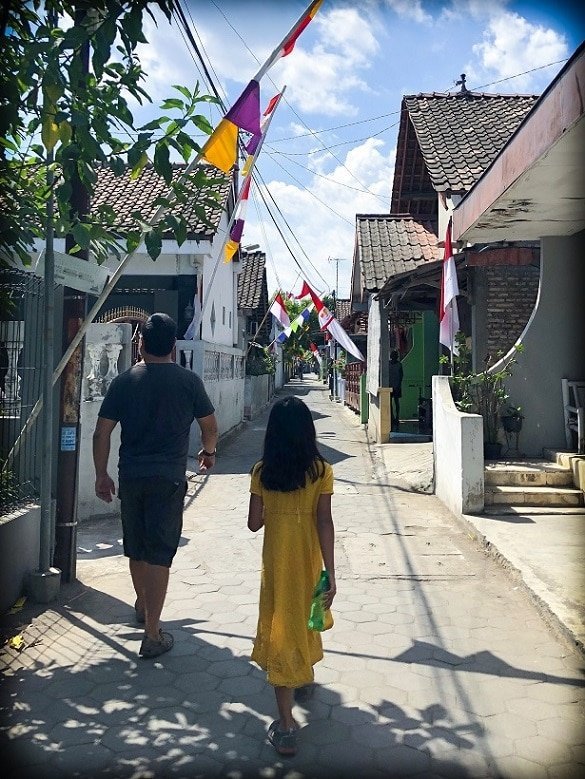
If you have a lot of baggage (or don’t want the hassle of dealing with taxis) you can hire a private transport from the airport or train station to the hotel.
So many things to do in Yogyakarta to truly experience Indonesian culture
There is so much for families to discover in Yogyakarta. Families who go to Bali just to see the Indonesian tourist attractions are certainly missing out!
We loved our time in Yogyakarta, and wished we could have stayed longer. We really felt like we had a chance to get to know Indonesian culture a lot better during our time there.
Have you visited Yogyakarta Indonesia before? What did you think about it?

Need help thinking through how to budget for a family trip? My Travel Budget Worksheet is just the tool you need! Click here to receive your free copy by signing up for my newsletter.
Want to connect with me on social media? Find me on Facebook, Instagram, Pinterest, and Twitter. And for those of you who are dedicated to traveling more responsibly, sustainably, and ethically, join over 500 like-minded families on my Facebook group, Responsible Family Travel.









